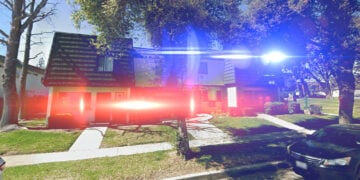Table of Contents
Almost all shooters practice static range shooting at fixed targets. Most of the time at the range when we do this we and the target are stationary and not moving. While this is great for building and practicing the fundamentals of shooting, it is not totally optimal for self-defense encounters where considerable movement is involved. When we are involved in a real self-defense or personal protection deadly-force encounter, more than likely we will be moving and shooting. It is almost a certainty that both the bad guy/gal and you will be moving. We will be moving away from the bad guy/gal who is shooting at us so we can escape and protect ourselves. Or, we may be advancing or retreating or moving sideways to get closer to the threat or to get away from the threat, for a distance advantage. Or, we will be moving to seek cover, to escape a second attacker, or to reposition ourselves for a better and safer offensive or defensive action.
Quick, Realtime Response Required
When we are involved in a real self-defense situation, we need essential skills beyond the usual basics. We need to learn and practice intermediate to advanced shooting skills in a fluid and safe environment and progress beyond stationary and fixed targets, situations, and responses. We must learn and practice in realistic scenarios that give us the opportunities to practically respond in real-time and quickly see the results of our actions. So, it is imperative that we develop and practice a comprehensive, more advanced, and practical list of self-defense skills that allow us to respond to more mobile and changeable situations that might just save our lives. Shooting on the move is just one very likely skill that we must know and practice. Of course, the fundamentals should not be neglected and must also be practiced in concert with the other necessary intermediate to advanced skills. There are essential fundamentals, techniques, and tips for shooting on the move and I want to share some with you. Shooting on the move involves a distinct process with definite steps and actions for success.
01
of 07
The Goal in Self-Defense Shooting
You are trying to save your life and the lives of your loved ones. So, your goal is to get hits on the threat or target quickly at the same time you are continuously and effectively moving in different directions, perhaps to cover. You want to get from Point A to Point B smoothly and without disturbing the sights. Now those hits do not have to be direct bullseye, center-mass hits and your group does not have to be a very precise two-inch group. You may not have the luxury of adequate time to properly do your sight alignment and get an optimal sight picture. In fact, you may not even have the time to align and use your sights at all and may shoot from the hip without proper aiming. And you may shoot with only one hand. But, you must stop the threat… and quickly, while you are moving for cover and/or escaping an attack, etc. Of course, if at all possible, avoid shooting on the move because of the inherent difficulty in getting effective hits to stop the threat and the many situational uncertainties, unless you have the priority of seeking cover. Naturally, this varies by situation. However, realistically, in almost all scenarios you will be moving and will need to shoot at the same time you are moving to get hits to stop the threat. And remember SAFETY is also very important when moving, so do not have your finger on the trigger when moving, have it placed on the gun’s frame, and keep your gun’s muzzle pointed down range or toward the threat when moving.
02
of 07
External Factors that Affect Accurate Hits on Target
There are five extrinsic, environmental factors that directly affect your capability to stop the threat and to do so quickly and effectively while moving. Here are the general external factors:
- Terrain and physical features of the land and environment, e.g. gravel, mud, sand, rain;
- Difficulty of the shot, e.g. one large target at three yards versus a small target at 25 yards;
- Number of threat targets, e.g. one attacker versus three attackers;
- Distance to the primary threat target and available cover; and
- Other unknown secondary threat or non-threat targets that are affected, e.g. family members, friends, or pets, or unknown, possible hostile opponents.
CAUTION: The tips, techniques, guidelines, and drill for shooting on the move presented here are strictly for general educational purposes. It is recommended that before you attempt them that you should first seek professional training from a reputable instructor about shooting on the move and about the basics of shooting. And that you first practice and master the fundamental skills and mechanics of handling and shooting a handgun. You should be able to consistently place hits on a target at seven yards while following handgun safety rules before you attempt shooting on the move and the indicated Drill.
03
of 07
Specific Tips and Techniques for Shooting on the Move
Of course, situations and factors involving moving and shooting can and do differ tremendously and, thus, the appropriate and optimal techniques also vary by situation. Be sure and master the basics of shooting and handling a gun safely before you practice shooting on the move. SAFETY FIRST! Here are my 14 general Guidelines for Shooting on the Move:
04
of 07
Col Ben’s 14 Guidelines for Shooting While Moving:
- Bend both knees to absorb the shock, to help prevent dramatically moving the sights, and to keep a low center of gravity to avoid the “bounce” of movement;
- When moving forward or advancing, move your feet in a rolling “heel-to-toe” sliding motion, putting your heel firmly and smoothly on the ground in front of yourself and rolling or gliding toward the toe (not flat-footed); keep both feet on the ground as much as possible for stability;
- When moving backwards or retreating, glide, and move your feet in a “toe-to-heel” deliberate motion to detect ground obstacles like rocks, so can quickly and securely get to cover because your weight is balanced (leaning slightly forward) and to avoid trips (more chances for errors when moving backwards);
- When moving to the right (as a right-hand shooter), turn and walk in the direction you want to go while rotating your body to the left and to the target/threat.
- When moving to the left (as a right-hand shooter), turn and walk in the direction you want to go while rotating your body to the right and to the target/threat; this is more challenging and you may want to shoot with only one hand when moving to the left as a right-hand shooter;
- Take short, small steps that are smooth, intentional, and calculated;
- Keep your feet in contact with the ground as much as possible to avoid trips and for stability;
- Move in a straight line like walking a tightrope to keep your balance and to keep your sights aligned (put one foot directly in front of the other);
- Minimize side-to-side motion and keep moving (do not stop and then shoot);
- Keep your feet pointed in the direction of your movement (even if your upper body is oriented in a different direction when moving, like towards the threat);
- Keep your upper body pointed at the threat as a solid base for any shooting and movement; e.g upper body should move like a “tank turret” rotating as necessary- to turn and aim the main tank gun [upper body and your pistol] without turning the tank [entire body] itself);
- Fire the shot when your feet are in motion, not when a certain foot hits the ground (causes muzzle movement) and not to slow or stop and then fire (avoid timing shots when a foot hits the ground or is lifted);
- Hold the gun very firmly while moving to steady the sights, manage felt recoil, and for overall control; and
- Be flexible and avoid being tense and rigid when moving to shoot (slightly bend your knees and bend your elbows and keep a straight line from your front sights through your locked shooting hand to your radius and ulna bones of your shooting arm, to help absorb vibrations, shock, and to better handle recoil.
05
of 07
Shooting from Cover Versus Concealment
“Cover” generally means positioning yourself behind an object to obscure your presence and to give yourself the greatest protection against a threat’s incoming bullets. For example a large tree. Some confuse cover with concealment. “Concealment” is basically a hiding place to obscure a person’s position, but usually does not give protection against bullets, e.g. a small bush. I have learned from my International Defensive Pistol Association (IDPA) competition matches that hugging cover or being very close to it is not an advantage. If you put some distance between yourself and the back of the cover, you are a smaller target for the attacker to engage and you are less likely to be seen and shot. More distance with cover gives the defender a higher degree of protection with minimal exposure, especially when the defender is shooting from behind cover and receiving fire. If the defender extends the gun and his body past the cover, both are at unnecessary risk for the defender’s gun being shot and put out of order and for injury. Be extremely careful when using cover and concealment and know their proper uses.
I have learned through my IDPA competition matches how to properly shoot from cover. Of course, these are not real-life self-defense situations and the targets are paper, stationary, and fixed. But still, I want to share with you some things I have learned about shooting from cover in competition.
I know that the shooter in IDPA must generally engage targets in the order that they see them, as you progressively lean out from cover. For example in competitive matches, if you are leaning out from the left side of your cover as a right-hand shooter, the shooter should engage the left-most target first and follow that by then shooting at the inward target(s). And if you are leaning out from the right side of cover in IDPA, engage the nearest right-most target first and work to the outside. So for IDPA purposes (which again are not actual real-time self-defense situations), I learned as a right-hander to primarily engage the targets from the “inside to the outside” when leaning and shooting from my usual right side of cover. And in IDPA they assess procedural penalties for engaging the targets out of order… and for exposing yourself to unengaged targets while engaging other targets.
06
of 07
A Basic Drill for Shooting on the Move: Col Ben’s Rhomboid Drill
It has been a while since I had my Geometry class and if I recall I did not get the best grade, but I do remember a few terms. One geometry-shape term is “Rhomboid.” By definition, a parallelogram has two pairs of parallel sides and two pairs of opposite sides that are congruent in shape. So, a Rhomboid is a parallelogram in which adjacent sides are of unequal lengths and have no right angles.
Rather than the shape of a square, I think a Rhomboid is the best depiction of the usual movements, distances, and dynamic directions of a self-defense shooter, in some common situations. We do not always, nor most of the time, move in straight lines at right angles, to the same distances, and in the same directions when shooting in an encounter. So to better represent the dynamic nature of deadly-force encounters, I chose the Rhomboid shape for my Drill with 4 different movement Directions (arrows #1 thru #4), with different distances to move and shoot toward the target (letters indicating Points A thru D with yards indicated), and call it the Rhomboid Drill for Shooting on the Move. Here is my Drill:
 Stages of Col Ben’s Rhomoid Drill
Stages of Col Ben’s Rhomoid Drill
The first stage begins at Point A as shown in the above diagram, and finishes at Point A after Point D. So the Start and Finish Points are the same. Remember, the top priority is SAFETY so ensure all 4 directions and movements toward them are safe to avoid injuries to yourself and others when shooting. Recognize that this drill is simple but challenging, but not easy to master. Practice it and initially take your time completing it.
While my drill has 4 set distances, 4 different directions, and number of shots and hits per the 4 targets, you can customize this drill for yourself and change any or all of them, according to your skills, progress, and available ammo and targets, etc. Foremostly, be safe!
Place 4 targets at the 4 points indicated by letters A, B, C, and D on the above drill diagram for the indicated different distances and directions. Then follow my tips and guidelines for Shooting on the Move for the 4 stages. The drill has 4 targets at different distances and in different directions and has a total of 12 rounds fired for the drill, 3 rounds from Point A, 3 rounds from Point B, 3 rounds from Point C, and 3 rounds from Point D. At first do not time the drill, but after you become familiar with it and feel safe shooting it, consider adding a timer to the drill to help your performance with a time goal for each Point. Set a goal for completing the drill, perhaps 5 seconds for each of the 4 Stages, so 3 shots from Point A to Point B in 5 seconds, 3 shots from Point B to Point C in 5 seconds, etc. Safety First Always!
Stage A: The shooter moves in direction 1 from Point A toward Point B, whose target is located 5 yards away, firing 3 shots (2 to body and 1 to head) while moving without stopping.
Stage B: Once at Point B, keep moving without stopping and keep shooting in direction 2 toward Point C whose target is 7 yards away, firing 3 shots (2 to body and 1 to head) while moving.
Stage C: Once at Point C, continue moving without stopping and keep shooting in direction 3 toward Point D whose target is 5 yards away, firing 3 shots (2 to body and 1 to head) while moving.
Stage D: Once at Point D, keep moving without stopping and keep shooting in direction 4 toward the Finish (and Starting) Point A, firing 3 shots (2 to body and 1 to head) while moving.
TIP: Do not stop to shoot when moving from Point to Point, but rather keep continuously moving to the next Point and keep shooting at the target. A key is to keep your feet moving when you break each shot. At first, for this drill moving smoothly is more important than getting center mass hits.
Hopefully, you can complete all 4 Stages, following my guidelines while continuously moving while shooting (no stopping) from Point A to Point D and back to Point A in 30 seconds or so, with 12 total hits on the 4 targets. At first, do not over-extend yourself and rush too much because this inherently makes for an unsafe shooting environment. I suggest that when you start practicing shooting on the move to NOT use a shot timer, so you can focus on the proper techniques without feeling hurried and unsafe. Techniques and fundamentals before speed. You may want to start with a goal of one minute or longer or whatever time you feel comfortable with for your skill level.
07
of 07
Conclusion
While static shooting skills and drills at fixed targets are important for learning and practicing the basic fundamentals, more advanced techniques and some different skills are required for shooting on the move. Mastering the basic shooting knowledge and skills are necessary before attempting movements in different directions while shooting at dynamic targets at different distances. Without any doubt, it is a challenge to keep your feet moving, follow the guidelines for shooting on the move, and quickly place an effective hit on targets at the same time. A shooter’s accuracy and safety can be hindered if proper guidelines and techniques are not followed. But you can move quickly and get accurate hits on target at the same time. There are differences for the self-defender to know to distinguish between shooting from cover and shooting from concealment. Just some of the techniques and guidelines are presented in this article, but others are necessary to learn and practice. For example, movement during reloads, movement to cover, and re-engaging multiple threats.
Continued Success and Be safe!
Photo by author.
* This personal opinion article is meant for general information & educational purposes only and the author strongly recommends that you seek counsel from an attorney for legal advice and your own personal certified weapons trainer for proper guidance about shooting & using YOUR firearms, self-defense, and concealed carry. It should not be relied upon as accurate for all shooters & the author assumes no responsibility for anyone’s use of the information and shall not be liable for any improper or incorrect use of the information or any damages or injuries incurred whatsoever.
© 2021 Col Benjamin Findley. All Rights Reserved. This article may not be reprinted or reproduced in whole or in part by mechanical means, photocopying, electronic reproduction, scanning, or any other means without prior written permission. For copyright information, contact Col Ben Findley at [email protected].



 Stages of Col Ben’s Rhomoid Drill
Stages of Col Ben’s Rhomoid Drill





